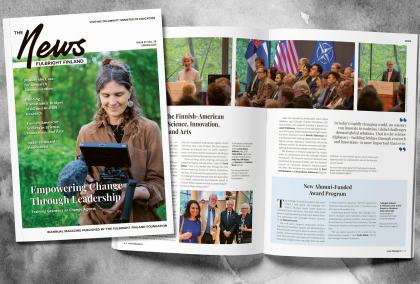A graduate-level Fulbright program applicant
A Fulbright program applicant has to attach letters of recommendation (in English) to their application. The letters of recommendation have an important role in the success of the application. With the letters, a recommender can provide reasons why the applicant would be an excellent choice to receive the grant. Along with the letters of recommendation, what matters in the selection process is the application itself, the applicant’s certificates, and the interview.
The applicant does not have to have secured a place of study at the time of applying for the Fulbright program. The search for a place of study is begun after the grantees have been selected. The selected grantees can use the letters of recommendation from their Fulbright applications in their applications to U.S. higher education institutions. In the U.S., the letters of recommendation play a very important role in the application process, along with the applicant's essays, test results, and grades. The importance of the letters of recommendation is particularly high at the end of the selection process, as all the finalists are often equal, and attempts to find differences between them are made.
The number of recommendation letters
Please attach three (3) letters of recommendation to your Fulbright application.
Usually you also need to attach at least three letters of recommendation in the graduate-level applications for U.S. higher education institutions. The number of the required letters of recommendation is informed in the application instructions of each institution.
Choosing the recommenders
Careful consideration should be put into who to ask for recommenders. Prefer, if possible, people who know you the best and who you think will write the most positive and efficient letter about you. The person’s status or title is not the most important aspect when choosing the recommender but you should rather ask a person who knows you and your ways of working well. In other words, the high status of a recommender alone is not enough to make the letter of recommendation convincing.
Examples of suitable recommenders to support your Fulbright grant application are professors and teachers who have taught you, your supervisors, and employers in your own field.
When choosing recommenders you can, if you wish, take into account the potential reference criteria of those U.S. higher education institutions that interest you, if at the time of writing the Fulbright application you already know which institutions you want to apply to. The U.S. higher education institutions might, for example, only accept recommendations from persons in specific positions.
Begin collecting the letters of recommendation well in advance; a few months before the application deadline at the latest. This gives your recommenders enough time to write the letters.
Assisting the recommender and the follow-up of the letter of recommendation
Discuss your academic plans and reasons to apply to study in the U.S. with your recommender before they write their letter of recommendation. Think about what you possibly want the recommender to emphasize in their letter in advance and bring these issues forth in your conversations. Provide your recommender with your latest academic certificates, the transcript of study records, your CV, and other possible certificates that help your recommender write an excellent letter of support for you.
Notify your recommender of the final deadline for the letter of recommendation. Ask if there are any questions that have come up when writing the letter, and remind them of the final deadline as it approaches. Find out before the deadline if the requested recommendations have arrived at the Foundation.
The template for the letter of recommendation and sending the letter
The recommendation letters addressed to the Fulbright program are submitted through an electronic grant application form. The applicant uses the application form to send the recommender an automated email containing the instructions for filling out the recommendation form. The applicant must also provide their recommenders with the Fulbright Finland Foundation instructions and tips on how to write a letter of recommendation for a Fulbright grant applicant.
- If the recommender is unable to complete the form online, the applicant must provide the recommender with a downloadable version of the form from the online application portal. After filling out the form, the recommender emails the form to the Fulbright Finland Foundation ([email protected]).
The right to see the letters of recommendation
In the Fulbright program application you are asked to give up the right to see your letters of recommendation ("Yes, I waive my right to review the information contained in the evaluations submitted by recommenders on my behalf"). The Fulbright Finland Foundation does not allow applicants to see their letters at any point of the selection process, or thereafter.
In addition, it is very common for the application forms for U.S. higher education institutions to ask you to decide whether or not you want to see the letters of recommendation after the selection process. At this point, you can decide whether you would like to see them or not.


